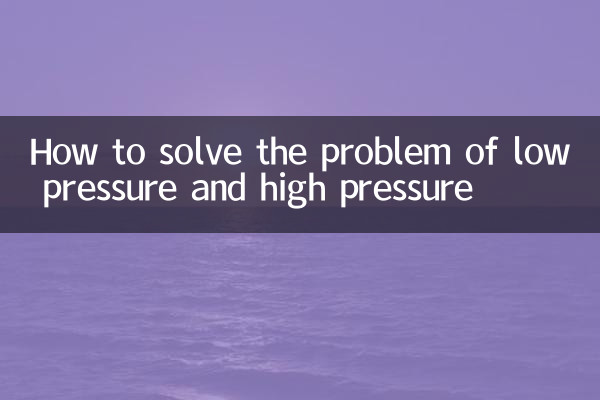Title: How to solve the problem of low voltage and high voltage
Low blood pressure (i.e. high diastolic blood pressure) is a common manifestation of hypertension, especially among young and middle-aged people. Among the hotly discussed health topics on the Internet recently, how to scientifically deal with low-pressure and high-pressure issues has become the focus. This article will analyze the causes, hazards, solutions and structured data to help readers systematically understand and improve this problem.
1. Causes and hazards of low pressure and high pressure

Elevated diastolic blood pressure is often associated with:
| Main causes | Specific performance |
|---|---|
| Decreased blood vessel elasticity | Arteriosclerosis, increased peripheral resistance |
| Bad living habits | High-salt diet, staying up late, drinking alcohol |
| mental stress | Long-term anxiety, sympathetic nervous excitement |
| Metabolic abnormalities | obesity, insulin resistance |
Long-term low and high pressure may cause:The risk of cardiovascular and cerebrovascular diseases increases by 2-3 times, kidney damage, fundus lesions and other complications.
2. Solution (structured data)
| Improvement direction | Specific measures | expected effect |
|---|---|---|
| diet modification | Daily salt intake ≤5g, increase potassium, magnesium and calcium foods | Diastolic blood pressure drops by 5-8mmHg after 2-4 weeks |
| exercise intervention | 150 minutes of aerobic exercise (such as brisk walking) per week | Can reduce 4-6mmHg in 3 months |
| stress management | Mindfulness meditation/abdominal breathing (20 minutes daily) | It can be reduced by 3-5mmHg for one month. |
| drug treatment | ARB/CCB antihypertensive drugs (doctor’s advice required) | Smoothly reduce blood pressure by 10-15mmHg in 24 hours |
3. Important matters needing attention
1.Monitoring specifications: It is recommended to use a certified electronic blood pressure monitor, sit quietly for 5 minutes before measurement, and measure once in the morning and evening for 3 consecutive days to take the average value.
2.Medication principles: When lifestyle intervention is ineffective for 3 months, or initial diastolic blood pressure ≥100mmHg, timely medical treatment is required.
3.Special groups: Pregnant women and diabetic patients need to develop personalized plans.
4. Recent hot topics
| Hot search keywords | focus of discussion | heat index |
|---|---|---|
| Young people have low pressure and high pressure | The relationship between workplace stress and blood pressure | 120 million |
| mediterranean diet | Antihypertensive effect of olive oil | 86 million |
| Ambulatory blood pressure monitoring | Masked hypertension screening | 65 million |
5. Long-term management suggestions
1. Createhealth record: Record daily blood pressure, diet, and exercise data, and use the health APP to analyze trends.
2. ParticipateCommunity supervision: Join the hypertension management group. The latest research in 2024 shows that the effect of group intervention is increased by 40%.
3. RegularlyVascular assessment: Carotid artery ultrasound, pulse wave detection and other examinations are performed every year.
Through systematic lifestyle intervention and scientific monitoring, most patients with low blood pressure and high blood pressure can achieve significant improvement within 3-6 months. It should be emphasized that blood pressure management is a long-term process and requires continuous persistence to achieve lasting results.

check the details

check the details